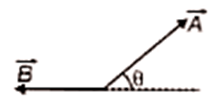Let \(\theta\) be the angle between vectors \(\overrightarrow A\) and \(\overrightarrow {B}\). Which of the following figures correctly represents the angle \(\theta\)?
1.

2.

3.

4.





If the angle between the two forces increases, the magnitude of their resultant:
1. Decreases
2. Increases
3. Remains unchanged
4. First decreases, then increases
The vector sum of two forces is perpendicular to their vector difference. In that case, the forces:
| 1. | are not equal to each other in magnitude. |
| 2. | cannot be predicted. |
| 3. | are equal to each other. |
| 4. | are equal to each other in magnitude. |
Current in a circuit is given by . Find charge that crosses a cross-section from time t=0 to t=2 sec.
1. 12 C
2. 10 C
3. 8 C
4. 2 C
The dot product of two mutual perpendicular vector is:
1. \(0\)
2. \(1\)
3. \(\infty\)
4. None of the above
When , then
1. and are perpendicular to each other
2. and act in the same direction
3. and act in the opposite direction
4. and can act in any direction
If for two vectors \(\overrightarrow{A}\) and \(\overrightarrow {B}\), \(\overrightarrow {A}\times \overrightarrow {B}=0\), then the vectors:
| 1. | are perpendicular to each other. |
| 2. | are parallel to each other. |
| 3. | act at an angle of \(60^{\circ}\). |
| 4. | act at an angle of \(30^{\circ}\). |
A particle moves from position null to \(\left(11\hat i + 11\hat j + 15\hat k \right)\) due to a uniform force of \(\left(4\hat i + \hat j + 3\hat k\right)\)N. If the displacement is in m, then the work done will be: (Given: \(W=\overrightarrow {F}.\overrightarrow {S}\))
1. \(100~\text{J}\)
2. \(200~\text{J}\)
3. \(300~\text{J}\)
4. \(250~\text{J}\)
A plane is revolving around the earth with a speed of 100 km/hr at a constant height from the surface of the earth. The change in the velocity as it travels half-circle is:
1. 200 km/hr
2. 150 km/hr
3. km/hr
4. 0
If vectors and are equal vectors, then the value of is:
1. -5
2. 2
3. -3
4. 4




